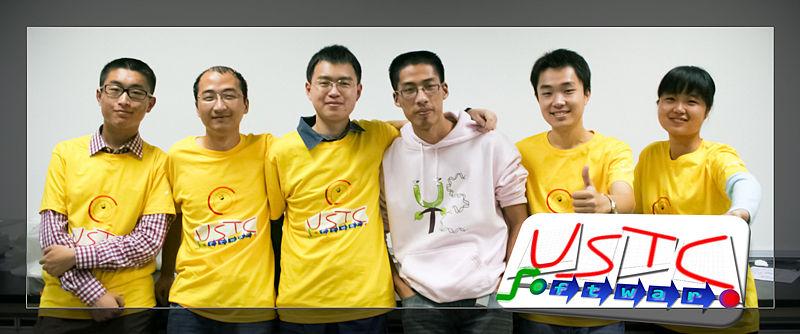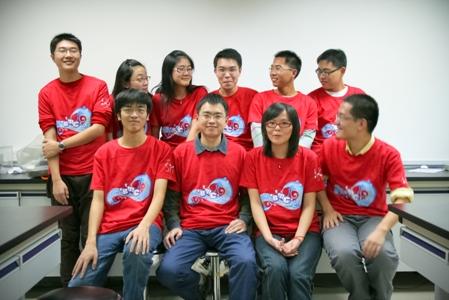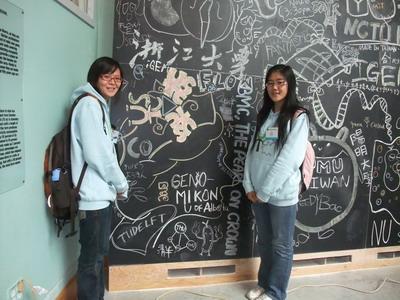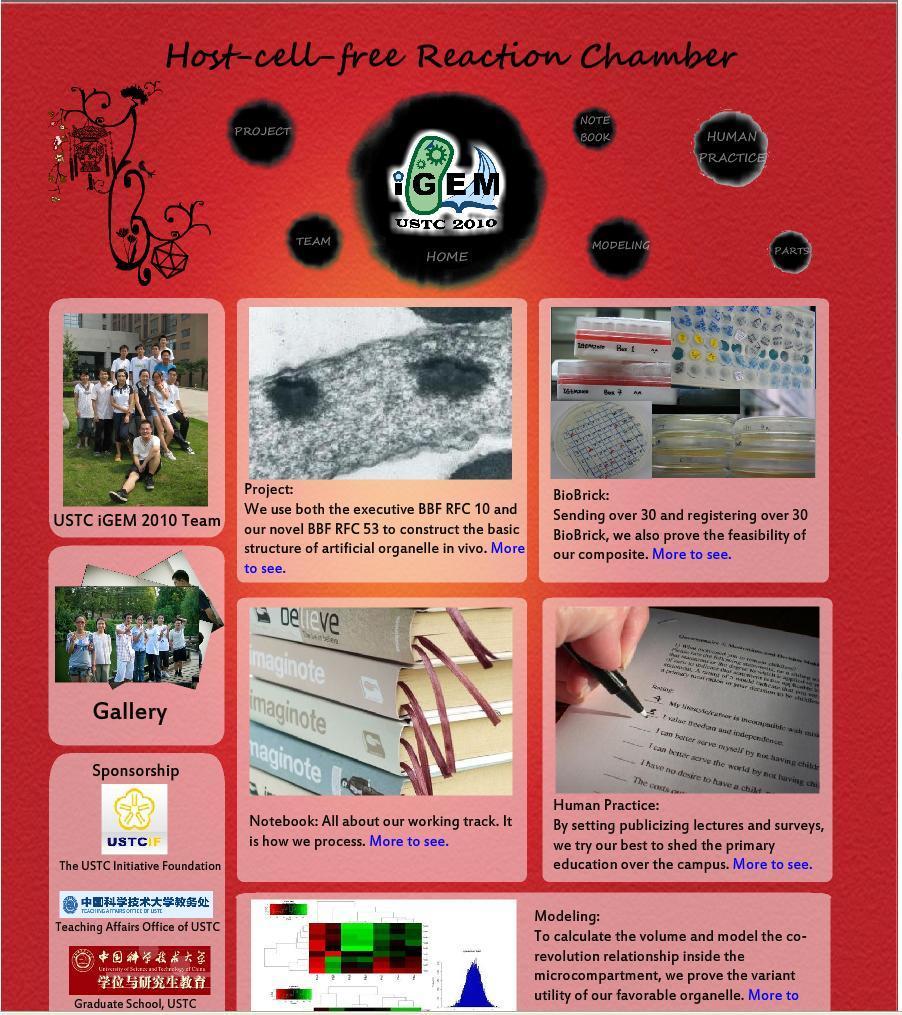[Special Report 2010-11-17] USTC Won Two Gold Medals and the Best software tool award in iGEM
Nov 8, 2010 EST, iGEM (International Genetically Engineered Machine) 2010, a competition conducted by the Massachusetts Institute of Technology, closed at Kresge Auditorium in MIT campus. Winning two gold medals in both two tracks: Manufacturing and Software Tools, USTC has become the only University in the world which won two golds. USTC has sent two separate teams this year, and the USTC Software team also won a track award: Best Software Tool!
iGEM 2010 was held in MIT which attracted 128 teams from 125 colleges to compete in, including MIT, Harvard, Stanford, University of California Berkeley, Cambridge, etc. Mainland China teams includes PKU, SJTU, Tianjin, Tsinghua, USTC and ZJU.


USTC iGEM Teams was formed in December, 2009. Through a long time of training and natural selection, two teams which consist of 26 undergraduate and graduate students (10 in software team and 16 in wet-lab team) were fixed and started to prepare for the competition. Team members came from various departments which includes School of Life Science, School of Physics, School of Chemistry, School of Computer Science, School for the Gifted Young, etc.
Advised by Prof. Jiarui Wu and Prof. Haiyan Liu, and instructed by Jiong Hong, Zhaofeng Luo, Hao Jiang and Wei Pan, team members worked in groups for investigating papers on Synthetic Biology and training experimental skills during the winter vacation. During the semester, group meeting was held every week for brainstorming and report.


In synthetic biology, we are in great need of an independent compartment and an integrated line to assemble disparate elements in cells. Thus iGEM USTC Team designed, modeled and constructed a platform for artificial organelles. The shell genes of Citrobacter freundii pdu bacterial microcompartment (BMC) were first constructed into BioBrick parts, assembled and expressed to form an empty porous multi-protein shell of ~100nm.
Then target protein can be located either inside or outside the empty shell by fusing the protein with signal sequences, using a novel and convenient assembly standard compatible with the RFC 10. Based on this platform, artificial organelles with different functions can be constructed. With enzymes or binding proteins inside the shell, different nanoreactors or nanoreservoirs can be produced.
Modifications outside the shell can be applied to build multi-protein super-complexes or facilitate downstream purification with affinity tags. Such a platform will make E. coil an integrated factory.
To promote public awareness of synthetic biology and introduce its basic ideas to the laymen, iGEM USTC Software Team devoted to the development of an experimental video game which aims at instructing non-biologists to design and improve biological systems. Following the games-with-a-purpose paradigm in which players help solve scientific problems, we attempt to apply the human brain's puzzle-solving abilities to the complex designs of biological systems.
While most of developed simulation tools are designed for experts to model the reaction networks from scratch, our game integrates a modeling environment in which users only need to submit their assembling of parts for our program to discover and generate the biological model automatically. With a mass of data for the use of modeling, we propose the Standard Biological Parts Modeling Database Language, which enables descriptions of complicated biological processes.
Furthermore, previous iGEM project models will be featured to demonstrate the availability of our idea.
The iGEM Team of USTC are the combination of the tradition of USTC and the vitality of the young. Rigorous daily schoolwork has provided the team members with a solid foundation of basic knowledge, and an innovative spirit enables them to stand on the frontier of the modern science.
In 2007, Jian Zhan, Bo Ding, Rui Ma, Xiaoyu Ma, Yun Zhao, Ziqing Liu and Xiaofeng Su, guided by Prof. Haiyan Liu, Prof. Jiarui Wu and Prof. Zhonghuai Hou, won the "Best Foundational Technology Prize" and a Gold Medal, with the project "Extensible Logic Circuit in Bacteria".
In 2008, Xunyao Wu, He Shen, Genxin Liu, Jia Liu, Binjie Xu, Yanting Xue, Yu Chen, Zhen Xu, Bo Ding and Jian Zhan, guided by Prof. Haiyan Liu, won a Silver Medal, with the project "Artificial Multi-cellular Self-organization System".
In 2009, Hao Jiang, Li Xing, Hao Wu, Zongxiao He, Danqian Liu, Chao Li, Jiayi Dou, Hanyu Lu, Hao Zhou and Bing Wu, guided by Zhaofeng Luo, Jian Zhan, Jiong Hong and Xiaoxiao Ma, won a Gold Medal, with the project "E. coli Automatic Directed Evolution Machine (E.ADEM)".
In 2009 we also formed a software team for the first time. Wei Pan, Yuwei Cui, Jiahao Li, Yu He and Xiaomo Yao, guided by Bo Ding, also won a Gold Medal, with the Project "Automatic Biological Circuit Design (ABCD)".
The International Genetically Engineered Machine competition (iGEM) is the premiere undergraduate Synthetic Biology competition. Student teams are given a kit of biological parts at the beginning of the summer from the Registry of Standard Biological Parts. Working at their own schools over the summer, they use these parts and new parts of their own design to build biological systems and operate them in living cells. This project design and competition format is an exceptionally motivating and effective teaching method.
iGEM began in January of 2003 with a month-long course during MIT's Independent Activities Period (IAP). The students designed biological systems to make cells blink. This design course grew to a summer competition with 5 teams in 2004, 13 teams in 2005 - the first year that the competition grew internationally - 32 teams in 2006, 54 teams in 2007, 84 teams in 2008, and 112 teams in 2009. Projects ranged from a rainbow of pigmented bacteria, to banana and wintergreen smelling bacteria, an arsenic biosensor, Bactoblood, and buoyant bacteria et al
For 2010 there are 128 teams participating and about 2000 participants taking part in the competition. They all specified, designed, built, and tested simple biological systems made from standard, interchangeable biological parts. Most of Teams presented their projects at the iGEM Championship Jamboree in November 2010.


The competition provided a global platform which youngsters majored in various study fields from different colleges and different countries can communicate with each other. Involved a self-conducted topic selection and hard lab work, submitting and representing the results to the committee, thus scientists and engineers from all over the world can benefit from iGEM publications in their research as a result, the iGEM competition not only improved both students' independent working skills and teamwork skills, but also stimulated students' enthusiasm for science.

During the competition, the USTC Initiative Foundation supported the USTC iGEM teams with an event named "Cheer up! Teams of Gold Medals", which attracted about 300 alumni from 10 countries to donate to USTC iGEM. Many USTC alumni in MIT and Harvard, even around Boston, helped teams during the jamboree as well.
The USTC Teaching Affair Office, Graduate School, Foreign Affair Office, School of Life Sciences, School of Physical Sciences, Department of Mathematics and School of Computer Sciences also supported the USTC iGEM teams. With all these supports, USTC iGEM teams have succeeded in iGEM 2010 with two gold medals and one track award.
(News Center of USTC, School of Life Science of USTC)
Related News
Photos
More>>history
- USTC President Jianguo Hou: An Honorary Doctorate by University of Birmingham
- CAS Vice President ZHAN Wenlong Visited NSRL in USTC
- USTC took the TOP 49th by the Times' 2010-11 world university rankings
- Big Success of the Cooperation between Chinese and US High-Energy Nuclear
- Fully Digital Beam Position Measurement System Made in China





